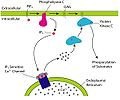Inositol trisphosphate
(Redirected from Inositol triphosphate)
Inositol trisphosphate (IP3) is a molecule that functions as a secondary messenger in cell signaling pathways. It is crucial in various biological processes, including the regulation of intracellular calcium levels, cell proliferation, and apoptosis. IP3 is derived from the phospholipid phosphatidylinositol 4,5-bisphosphate (PIP2) in the cell membrane upon activation of G protein-coupled receptors (GPCRs) or receptor tyrosine kinases (RTKs).
Biosynthesis
The biosynthesis of IP3 begins with the activation of phospholipase C (PLC), an enzyme that catalyzes the hydrolysis of PIP2 into IP3 and diacylglycerol (DAG). This reaction is triggered by various stimuli, including hormones, growth factors, and neurotransmitters, which bind to their respective receptors and activate PLC through GPCRs or RTKs.
Function
The primary function of IP3 is to mobilize calcium ions (Ca^2+) from the endoplasmic reticulum (ER) into the cytoplasm. IP3 binds to IP3 receptors (IP3R) located on the ER membrane, causing the release of Ca^2+ into the cytosol. This increase in intracellular Ca^2+ concentration serves as a signal for various cellular responses, such as muscle contraction, secretion, metabolism, and gene expression.
Signaling Pathways
IP3 is involved in several signaling pathways, including those regulating cell growth, differentiation, and survival. The interaction between IP3 and its receptors is a critical point of regulation in these pathways. Abnormalities in IP3 signaling have been implicated in various diseases, such as cancer, cardiovascular diseases, and neurological disorders.
Metabolism
After fulfilling its role, IP3 is rapidly metabolized by specific phosphatases into inositol bisphosphate (IP2), inositol monophosphate (IP1), and eventually myo-inositol, which can be recycled to regenerate PIP2. This ensures that the cell can quickly respond to new signals.
Clinical Significance
Given its role in calcium signaling and cell regulation, IP3 and its signaling pathway are targets for therapeutic intervention in several diseases. Drugs that modulate the IP3 signaling pathway have potential applications in treating conditions such as heart disease, cancer, and bipolar disorder.
See Also
This article is a biochemistry stub. You can help WikiMD by expanding it!
Inositol_trisphosphate
Transform your life with W8MD's budget GLP-1 injections from $125.
W8MD offers a medical weight loss program to lose weight in Philadelphia. Our physician-supervised medical weight loss provides:
- Most insurances accepted or discounted self-pay rates. We will obtain insurance prior authorizations if needed.
- Generic GLP1 weight loss injections from $125 for the starting dose.
- Also offer prescription weight loss medications including Phentermine, Qsymia, Diethylpropion, Contrave etc.
NYC weight loss doctor appointments
Start your NYC weight loss journey today at our NYC medical weight loss and Philadelphia medical weight loss clinics.
- Call 718-946-5500 to lose weight in NYC or for medical weight loss in Philadelphia 215-676-2334.
- Tags:NYC medical weight loss, Philadelphia lose weight Zepbound NYC, Budget GLP1 weight loss injections, Wegovy Philadelphia, Wegovy NYC, Philadelphia medical weight loss, Brookly weight loss and Wegovy NYC
|
WikiMD's Wellness Encyclopedia |
| Let Food Be Thy Medicine Medicine Thy Food - Hippocrates |
Medical Disclaimer: WikiMD is not a substitute for professional medical advice. The information on WikiMD is provided as an information resource only, may be incorrect, outdated or misleading, and is not to be used or relied on for any diagnostic or treatment purposes. Please consult your health care provider before making any healthcare decisions or for guidance about a specific medical condition. WikiMD expressly disclaims responsibility, and shall have no liability, for any damages, loss, injury, or liability whatsoever suffered as a result of your reliance on the information contained in this site. By visiting this site you agree to the foregoing terms and conditions, which may from time to time be changed or supplemented by WikiMD. If you do not agree to the foregoing terms and conditions, you should not enter or use this site. See full disclaimer.
Credits:Most images are courtesy of Wikimedia commons, and templates, categories Wikipedia, licensed under CC BY SA or similar.
Contributors: Prab R. Tumpati, MD


